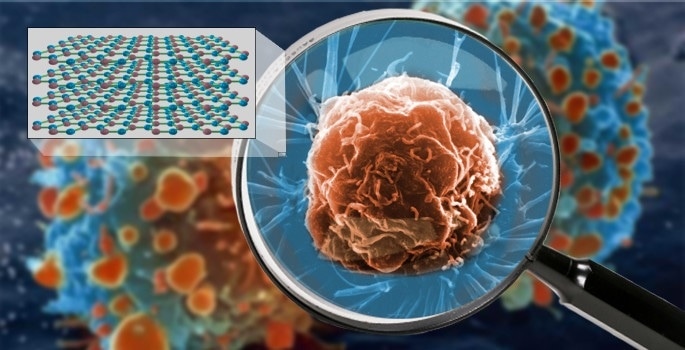Dec 12 2017
Just imagine: An optical lens so powerful that it allows users to view features the size of a small virus on a living cell’s surface in its natural environment.
 New hyperlens crystal is capable of resolving details as small as a virus on the surface of living cells. The atomic structure of the hexagonal boron nitride crystal is shown in the cutout. Credit: Keith Wood / Vanderbilt
New hyperlens crystal is capable of resolving details as small as a virus on the surface of living cells. The atomic structure of the hexagonal boron nitride crystal is shown in the cutout. Credit: Keith Wood / Vanderbilt
It is now possible to construct instruments with this capability due to a fundamental advance in the quality of an optical material employed in hyperlensing, a technique used for creating lenses that can resolve much smaller objects than the wavelength of light. This finding was reported in a paper published on November 11th, 2017 in the Nature Materials journal by a team of researchers headed by Joshua Caldwell, associate professor of mechanical engineering at Vanderbilt University.
The optical material included is hexagonal boron nitride (hBN), a natural crystal with hyperlensing properties. Using hBN, the best previously reported resolution was an object about 36 times smaller compared to the infrared wavelength used: approximately the size of the smallest bacteria. The new paper explains enhancements in the quality of the crystal that improves its potential imaging capability by about a factor of ten.
The researchers attainted this improvement by creating hBN crystals using isotopically purified boron. Natural boron consists of two isotopes that vary in weight by about 10%, a combination that considerably degrades the optical properties of the crystal in the infrared.
We have demonstrated that the inherent efficiency limitations of hyperlenses can be overcome through isotopic engineering. Controlling and manipulating light at nanoscale dimensions is notoriously difficult and inefficient. Our work provides a new path forward for the next generation of materials and devices.
Alexander Giles, Team Member and Research Physicist, The U.S. Naval Research Laboratory
The study also included researchers from Columbia University, Oak Ridge National Laboratory, Kansas State University, and the University of California, San Diego.
The researchers calculate that a lens created from their purified crystal can technically capture images of objects as small as 30 nm in size. To put this a better way, there are 25 million nm in an inch and human hair ranges from 80,000 to 100,000 nm in diameter. A human red blood cell is approximately 9,000 nm and viruses range from 20 to 400 nm.
Over the years, researchers have developed numerous instruments capable of generating images with nanoscale resolution, such as atomic-force and electron-based microscopes. However, they are not compatible with living organisms: either they function under a high vacuum, require lethal sample preparation methods like freeze drying, expose samples to harmful levels of radiation, or remove samples from their natural, solution-based environment.
The main reason for making hyperlenses is the prospect that they can offer such extremely detailed images of living cells in their natural environments with low-energy light that does not harm them. Furthermore, employing infrared light to perform the imaging can also offer spectroscopic information about the objects it images, offering a way to ‘fingerprint’ the material. These capabilities can have a major impact on medical and biological science. In addition, the technology has potential applications in nanoscale optical and communications components.
Hyperlenses’ physics is quite complex. The level of detail that optical microscopes can image is limited by the index of refraction of the lens material and the wavelength of light. This translates to a typical optical limit of approximately one-half the wavelength used for imaging when combined with the factors of lens aperture, the refractive index of the object under observation and distance from the object to the lens.
The “diffraction limit” is about 3,250 nm at the infrared wavelengths used in this experiment. This limit can be exceeded by using hBN due to its capability to support surface phonon polaritons, hybrid particles comprised of photons of light pairing with vibrating, charged atoms in a crystal that have much shorter wavelengths than the incident light.
Earlier, the problem with employing polaritons in this manner has been the speed with which they dissipate. The researchers have measured an extraordinary reduction in optical losses compared to natural crystals and increased the polariton’s lifetime three-fold, which lets them travel triple the distance. This enhancement translates into a significant enhancement in imaging resolution. The theoretical analysis carried out by researchers suggests that an additional factor of ten improvement is possible.
Currently, we have been testing very small flakes of purified hBN. We think that we will see even further improvements with larger crystals.
Joshua Caldwell, Associate Professor, Mechanical Engineering, Vanderbilt University
In 1654, Anton van Leeuwenhoek employed one of the first handcrafted microscopes to find out the previously unknown world of microscopic life. This recent advancement in hyperlens development is a major step toward taking the discovery of van Leeuwenhoek to an entirely new level, one which will enable biologists to directly view cellular processes in action, like immune cells attacking foreign invaders or viruses invading cells.
Other researchers involved in this research include D.N. Basov at Columbia University; Lucas Lindsay at Oak Ridge National Laboratory; J.H. Edgar, Timothy Hoffman, and Song Liu at Kansas State University; Ioannis Chatzakis, Nathanael Assefa, Joseph G. Tischler, Thomas L Reinecke, Chase T. Ellis, Igor Vurgaftman and Alexander J. Giles at the U.S. Naval Research Laboratory; and Michael M. Fogler and Siyuan Dai at the University of California, San Diego. A number of components and participants of this work were funded in part or whole by the U.S. Department of Energy, the National Science Foundation, the Air Force Office of Scientific Research, the Army Research Office, and the Office of Naval Research.